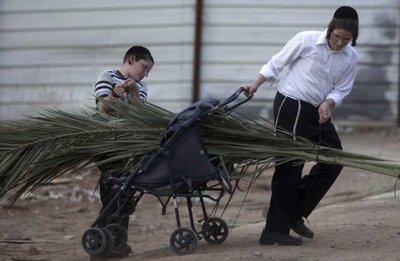 New York – The week-long Jewish festival of Sukkot, commemorating G-d’s protection of the Jews during their 40-year sojourn prior to entering the Promised Land, begins Wednesday evening.
New York – The week-long Jewish festival of Sukkot, commemorating G-d’s protection of the Jews during their 40-year sojourn prior to entering the Promised Land, begins Wednesday evening.
Subscribe to our Daily Roundup Email
On this holiday, Jews build, eat, relax and many even sleep in temporary booth-type structures, sukkot, reminding them of their desert dwellings and of the Clouds of Glory that protected them during that time.
Beginning at sundown, Sukkot is one of the three major festivals (shlosha regalim) of the Jewish calendar in which the Jewish People were enjoined to “go up to Jerusalem.” It is called the ‘festival of rejoicing’, and the entire Hallel prayer is said each day of the holiday.
While the holiday lasts for Eight days, only the first Two days is regarded as a Sabbath-like “Holy Day” on which most Sabbath restrictions, except for preparing food for that day, apply.
The third through seventh days are known as “Chol HaMoed,” literally meaning a combination of holiday (moed) and weekday (chol).
On these days, most ordinary activities are permitted. It is customary to see mass outings of families and friends throughout New York and beyond enjoying festivities.
Sukkot is followed by the holiday of Shmini Atzeret – the Assembly of the Eighth Day – which is considered a separate holiday on which Yomtov restrictions apply and on which the solemn prayer for rain is said.
Shmini Atzeret, is followed by Simchat Torah, the celebration of Torah, during which communities feast, dance with the Torah scrolls, and celebrate the annual conclusion of the Torah-reading cycle.
One of the most important customs of Sukkot is the recitation of the blessings over the Four Species: an etrog (citron), a lulav (palm frond), three sprigs of hadassim (myrtle) and two branches of aravot (red willow). These have to meet halakhic specifications, so it is recommended to purchase them from a reliable source or buy a ready made set with rabbinic certification.
Note: VIN News will be offline from Oct 12 6:00 PM EST, until Oct 15 2011, 8:00 PM EST. Chag Sameach to all our readers and supporters. Reminder: Prepare your Eruv Tavshilin

dont 4get eruv tavshilin
No later than 18 minutes before sunset tonight (Wednesday), take a cooked item and a baked item (custom is a hard boiled egg and a small challah – but anything similar will do). Recite the berachah “Baruch ata Adon.. Eloheinu Melech haolam asher kidishanu bemitzvosav vetzivanu al mitzvas eruv.” Then recite the Aramaic formula which begins “bahadein eruva…”. If you don’t understand the Aramaic, say it in English. Loosely translated it is “with this Eruv it shall be permitted for us to bake, cook, contain [food], to light fire, and to fix prepare and perform all of our needs on Yom Tov for Shabbos (for us, and all of Israel who dwell in this city).”
The custom is to eat the Eruv Tavshilin foods at the Third Meal (Shalosh Se’udos) on Shabbos.
Have a good Yom Tov!